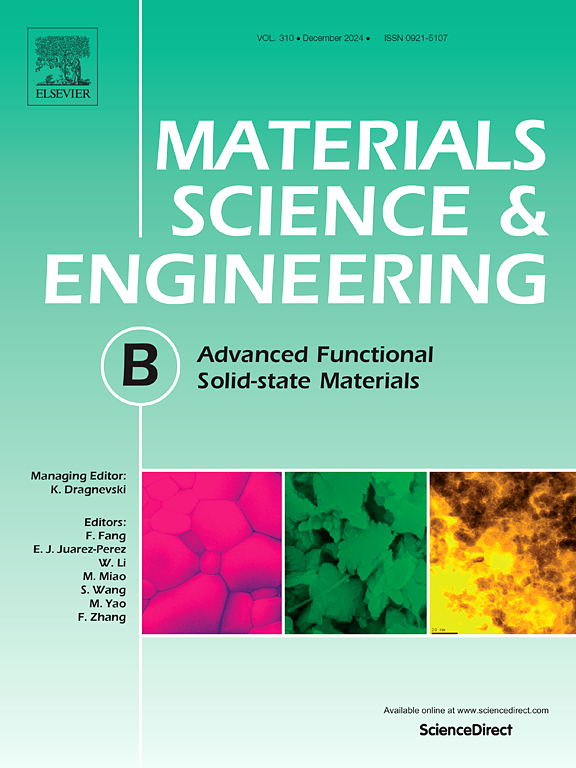基于p-TiO2 NP /n-ZnO NS异质结界面的室温选择性丙醇传感器
IF 4.6
3区 材料科学
Q2 MATERIALS SCIENCE, MULTIDISCIPLINARY
引用次数: 0
摘要
本文介绍了室温下p-TiO2纳米颗粒/n-ZnO纳米片异质界面的2-丙醇传感。采用溶胶-凝胶法、低成本水热法和热处理法制备了p-TiO2纳米颗粒和n-ZnO纳米片。通过x射线衍射(XRD)、场发射扫描电镜(FESEM)、原子力显微镜(AFM)、能量色散谱(EDS)和电流电压特性对其结构、形态、化学成分和界面质量进行了表征。p-TiO2纳米颗粒/n-ZnO纳米片的室温传感机制主要是由于p-n异质界面的协同作用,与p-TiO2纳米颗粒的近表面空穴积累有关,有利于2-丙醇的氧化。2-丙醇传感性能优异,在室温下的响应时间和恢复时间分别为~ 71 s和~ 85 s,响应幅度为68%。乙醇、甲醇、丙酮、苯、甲苯和二甲苯等干扰物对2-丙醇的选择性测定结果表明,2-丙醇-二甲苯的选择性窗口最大为60%,2-丙醇-乙醇的选择性窗口最小为11%。恒定的基线电阻(空气中为~ 2.5 MΩ, 2-丙醇中为~ 7.4MΩ)和重复性特性的最小波动(响应幅度、响应时间和恢复时间分别为±1.23%、±3.65%和±4.25%)表明设备具有良好的可靠性。本文章由计算机程序翻译,如有差异,请以英文原文为准。
Room temperature selective propanol sensor based on p-TiO2 NP /n-ZnO NS heterojunction interfaces
Room temperature 2-propanol sensing of p-TiO2 nanoparticles/n-ZnO nanosheets hetero interfaces is presented in this article. p-TiO2 nanoparticles and n-ZnO nanosheets was synthesized via sol–gel and low cost hydrothermal and methods followed by heat treatment. Structural, morphological, chemical composition and interface quality were characterized though X-Ray diffraction (XRD), Field Emission Scanning Electron Microscopy (FESEM), Atomic force microscopy (AFM), Energy dispersive spectroscopy (EDS), and current voltage characteristics, respectively. Room temperature sensing mechanism of p-TiO2 nanoparticles/n-ZnO nanosheets is primarily due to the synergistic effect of p-n hetero interfaces in association with near surface hole accumulation (of p-TiO2 nanoparticles) facilitates easy oxidation of 2-propanol. 2-propanol sensing performance showed excellent response magnitude of 68 % with response time and recovery time as ∼ 71 s and ∼ 85 s, respectively at room temperature. Selectivity measurement towards 2-propanol with the other interfering species such as ethanol, methanol, acetone, benzene, toluene and xylene showed maximum selectivity window of 60 % (between 2-propanol-xylene) and the least of 11 % (between 2-propanol-ethanol). Constant baseline resistance (∼2.5 MΩ in air and ∼ 7.4MΩ in 2-propanol) and minimum fluctuation in repeatability characteristics (±1.23 %, ±3.65 %, and ± 4.25 % in response magnitude, response time, and recovery time) suggested good reliability of the devices.
求助全文
通过发布文献求助,成功后即可免费获取论文全文。
去求助
来源期刊

Materials Science and Engineering: B
工程技术-材料科学:综合
CiteScore
5.60
自引率
2.80%
发文量
481
审稿时长
3.5 months
期刊介绍:
The journal provides an international medium for the publication of theoretical and experimental studies and reviews related to the electronic, electrochemical, ionic, magnetic, optical, and biosensing properties of solid state materials in bulk, thin film and particulate forms. Papers dealing with synthesis, processing, characterization, structure, physical properties and computational aspects of nano-crystalline, crystalline, amorphous and glassy forms of ceramics, semiconductors, layered insertion compounds, low-dimensional compounds and systems, fast-ion conductors, polymers and dielectrics are viewed as suitable for publication. Articles focused on nano-structured aspects of these advanced solid-state materials will also be considered suitable.
 求助内容:
求助内容: 应助结果提醒方式:
应助结果提醒方式:


